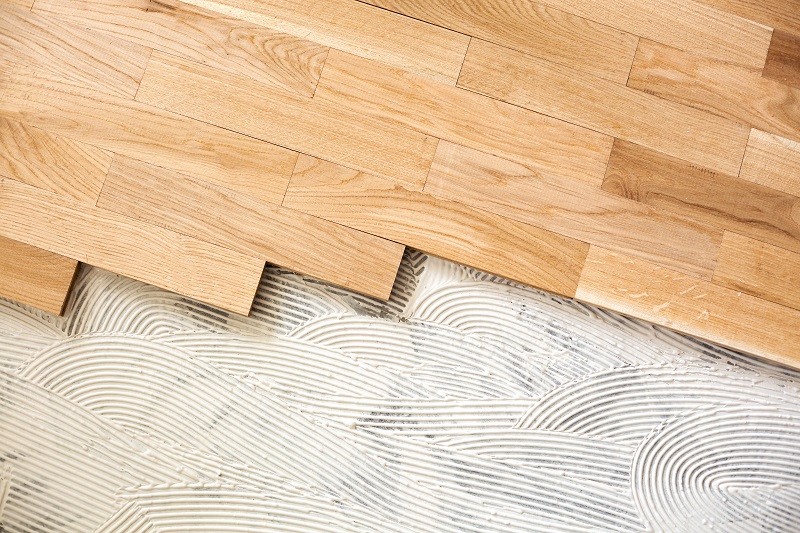Don’t Let Damaged Subfloor Derail Your Flooring Installation

When you think about your floors, you probably think about the carpet, hardwood, tile, or whatever other styles you have around your home. While the floors in your home are obviously important for aesthetics and comfort, not many folks think about the other floors in their home. These floors are just as, if not even more, important than the floors you walk around on. We are talking about the floors underneath your floors: your subfloors.
What is the subfloor?
Typically made from wood planks, OSB (Oriented Strand Board), plywood, concrete, gypsum, and even particle board, your subfloor provides a stable surface over your floor joists and provides a solid foundational layer beneath your floors throughout your house. Without it, there would be no flat base for your beautiful finished floors to sit upon.
While it is typically out of sight and out of mind because of the attractiveness of your carpet, hardwood, tile, luxury vinyl plank (LVP), or laminate, your subfloor plays a very, very important role. Over time, the condition of your subfloor can begin to deteriorate or it can become damaged for a number of reasons. Excess humidity or moisture can cause it to dip, cup, or warp unevenly and wear and tear can cause cracks and other damage over time.
Dangers of a damaged subfloor
When the condition of your subfloor is compromised it can begin to cause damage to your finished floors due to the unevenness of the surface you walk on. Tile, hardwood, laminate, and resilient surfaces can crack, bubble, and become displaced, causing you to replace portions of your flooring or even the entire room. But, there’s a big catch.
For those considering updating your flooring, a damaged subfloor is a particularly critical issue. Although inadvisable, you can hide some imperfections in your subfloor with carpet, but any type of hard surfaces such as hardwood, laminate, LVP, and tile require a flat surface to be installed correctly. Trying to install these styles of flooring over uneven or damaged subflooring will result in them being installed incorrectly or unevenly and making them vulnerable to damage soon after the installation is performed.
In addition, installing these hard surfaces over an uneven subfloor voids the respective manufacturer’s warranty. Your existing floor imperfections can be difficult to spot, and many issues with your subfloor cannot be determined and remedies recommended until the installation process has begun. At that point, the installation is put on hold until the issues are addressed and resolved. So, if your subfloor is not in the proper condition, your project will be interrupted, and you will have additional unexpected expenses incurred. Floor corrections are, unfortunately, a hidden flooring cost that many installers won’t talk about with their customers until the very end.
Signs of a damaged subfloor
If you want to ensure that any upcoming flooring project doesn’t get derailed, it is important to recognize it beforehand and make sure that you have a plan to get it taken care of. Here are four of the most common signs of subflooring damage.
Creaking and squeaking floorboards
When you walk across a room, whether it is carpet or hardwood, keep an ear open for creaking and squeaking. This is a sure sign that there are some issues or damage to your subfloor that has caused the nails securing the subfloor to the joists to loosen. So, when you walk across them, the subfloor moves and scrapes the nails causing the noise.
Noticeable bounce
Having carpet with a little bounce feels great under your bare feet, but floors that feel downright springy are worrisome! Flooring with a noticeable large bounce or “deflection” is another sign that the subfloor and joists are loose or damaged, causing it to shift and spring under the weight of foot traffic. It could also be the joists on your subfloor are too far apart and the improper subfloor is installed.
Cracked tile and warped plank
Have you noticed cracked tiles in kitchens and bathrooms? Well, if you didn’t recently cause it yourself by dropping something heavy, it is likely a symptom of an uneven or damaged subfloor. If your subfloor is uneven, it will put pressure on your finished floors. In the case of a rigid floor like tile, that pressure can force it to crack. So, in the case of the mysterious cracking tile, the culprit is likely what lies underneath. In non-tiled rooms, this issue will reveal itself as warped or uneven laminate, hardwood, or resilient plank.
Musty smell
If you have been dealing with a musty smell in one room but can’t find the source, it could be moisture damage to your subfloor. Excess moisture, whether it is from a recent leak, spill, or simply high humidity, can soak into your subfloor. If not taken care of right away, mold and mildew can begin to form as it deteriorates. Mold and mildew are obviously one of the most problematic issues to let linger, so this needs to be addressed ASAP. Warped or cupped planks are also a potential sign of moisture damage as well.
Tish Flooring can help!
It can be difficult to identify subfloor damage and issues on your own, but here at Tish Flooring we honestly and with transparency help homeowners address and correct subfloor concerns so their new flooring looks its best for as long as possible and their investment is protected.
We cannot always catch the issues early in the process, as quite often the existing floor covering needs to be removed so we can perform an assessment of the substrate. This enables us to fully understand and convey to the homeowner how to properly prepare it for their new flooring covering. Not addressing subfloor concerns can cause major problems down the line and delay your flooring project from being completed. So let the flooring experts at Tish Flooring help make sure that doesn’t happen!
At Tish Flooring, our process revolves around our all-important in-home visits. This helps you to see a variety of samples in your home and in your own lighting and space so you get to see exactly what your new floors will look like. It also allows our team to take measurements and an opportunity to discuss the importance of a properly prepared subfloor.
Our dedicated Tish Team will walk with you “hand in hand” every step of the way during your flooring replacement project. Our installation teams will alert us to any potential issues so we can bring them to your attention. Since the existing floor covering needs to be removed, in most cases, to properly assess your subfloor, you may not receive full details on what preparation your subfloors need until the project is already underway. We will make a game plan for getting it taken care of so you can make the best and most informed decision possible. At that point, we will work with you to manage the unexpected costs of your subfloor repairs. Our in-home visit, measuring, and subfloor assessments are the first and most important steps to ensure your new flooring will look great and last while you are in the home.
Call 317-879-(TISH) 8474 today to schedule your free, in-home estimate.

